

Swiftech Apogee GT CPU Waterblock Review
Introduction
Welcome to my review of the Swiftech Apogee GT CPU water block designed for a wide range of processors. This is an actual production run copy that comes standard with an LGA775 mount.
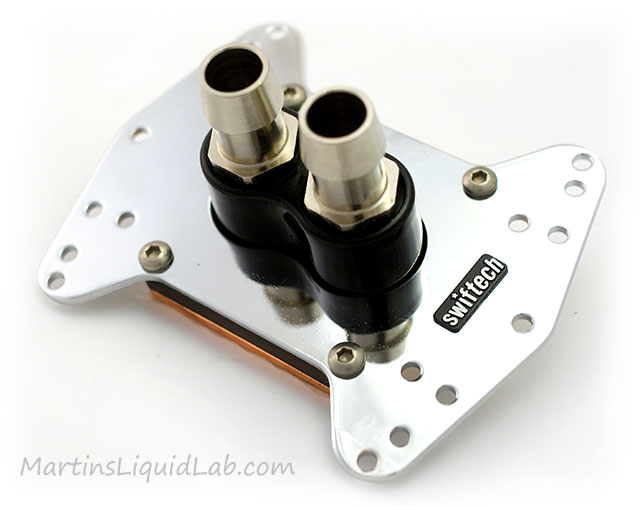
The above photo is the block itself with D-Tek Metal barbs (Kit comes with plastic barbs)
Before I continue, I would like to give special thanks to Gary from Sidewinder Computers for providing me with the Q6600 processor to test with. Sidewider Computers is one of my favorite places to shop for water cooling gear. They carry a wide range of products at typically the lowest prices. And what is even more important to me, they are very committed to advancements in this industry and are very active in the community. I highly recommend you giving Sidewinder computer systems a visit on your next build!
Block Characteristics
The block is a redesign or micro design of the original diamond pin matrix design of the Apogee original. It's a fairly simple two layer block with an inlet and outlet oriented side by side such that water cools the block by being forced through the diamond pin matrix base. In addition the new GT model comes with an optional thicker "bowing" o-ring, which I understand is how they are shipped today.My first order of review is looking at the packaging and accessories. This is how the water block is packaged, it comes in a blister pack type of packaging, that does hold the product and accessories separately in order well, albeit perhaps not as well protected as a box with foam padding to resist impacts in shipping.
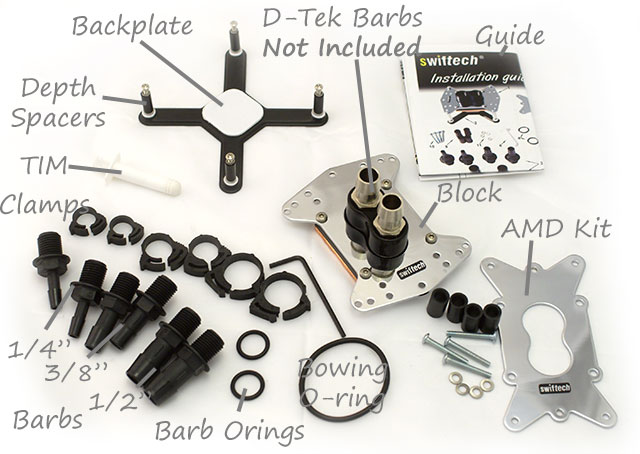
Swiftech really goes out of their way to give you everything you can possibly need to install the block. Many blocks require you to make additional purchases like the back plate (which I think is absolutely necessary for every water block installation), not to mention the barbs, clamps, and thermal paste. The only thing I don't care for are the plastic barbs, they function ok, but feel rather cheap, have a tendency to be difficult to remove 7/16" tubing, and can turn in their threads when trying to remove tubing. For these reasons I prefer switching these out to some metal barbs, although I appreciate the wide variety of barbs supplied in the package, they really give you everything you could possibly need here.
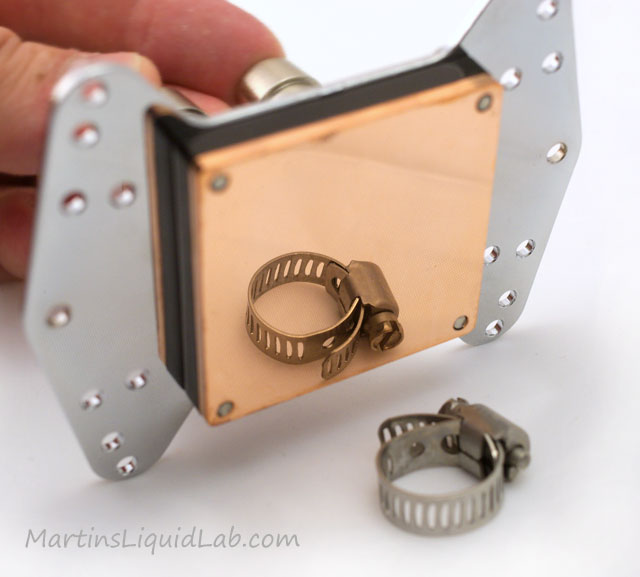
The base is a nice mirror finish, and bowed purposely around the center of the base.
When you take the block apart, you'll find only a few typical parts. The cast black aceta/delrin top with the chrome plated steel hold down, an o-ring, and a CNC machined copper base with a very fine diamond pin matrix design. Also note the top has funnel shaped flow spreader notches in the top, this allows the water to spread out from the barb holes and flow more evenly across the base.
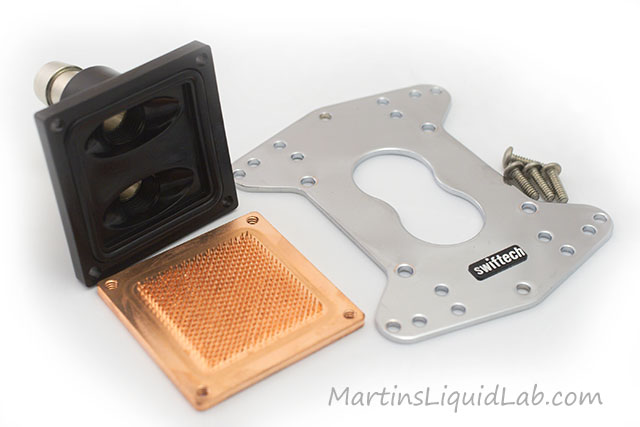
Simple easy to maintain design, just note that the diamond pins must be oriented correctly such that they point from one barb to the next and don't restrict flow too much.
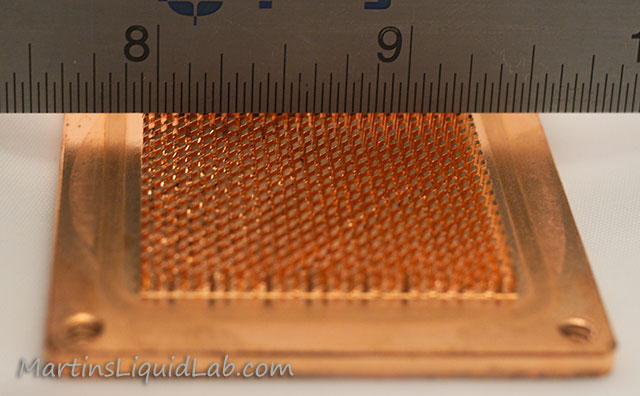
Just for scale, you can see each diamond pin is very small, this is likely cut using CNC milling machines and jewelers slitting saws.
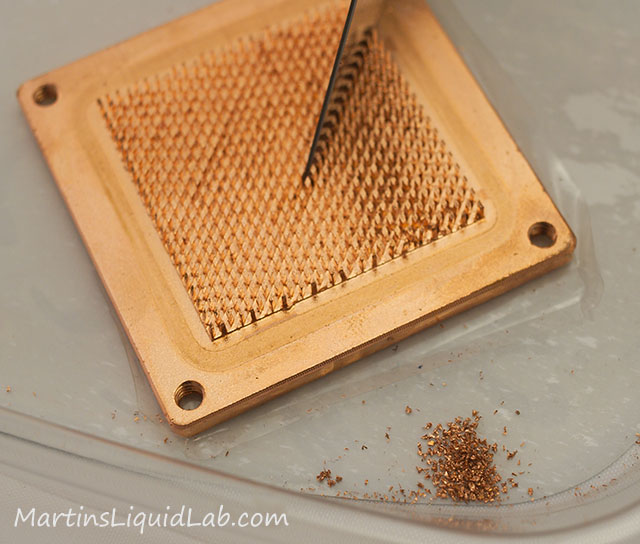
One issue I had with my particular copy was machining burs left behind. Typically these are removed by bead blasting. I did not see this in my Apogee Drive which is the same base nor my old MCW-60 which has similar construction, so I think this was more of the exception and not typical. Regardless, I had burs present, so I spent a few minutes with a razor blade and cleaned out those burs, this would ensure performance more closely matches a typical block.
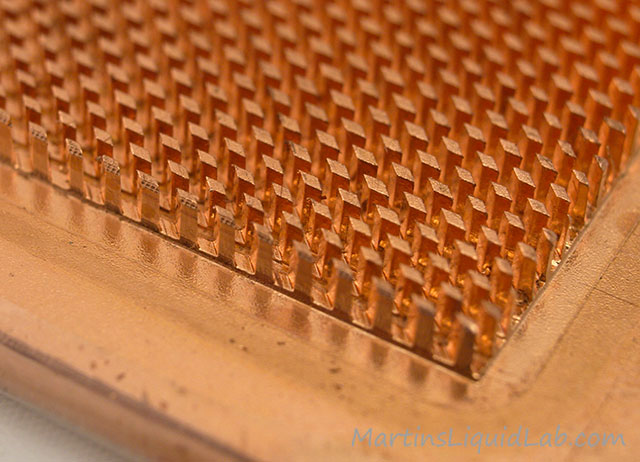
Here is a macro of the pins after clean, they are all very uniform and precisely machined and of the diamond shape.
This diamond pin shape prevents the water from standing still, it is constantly being split and scrubbing the walls of the pins.
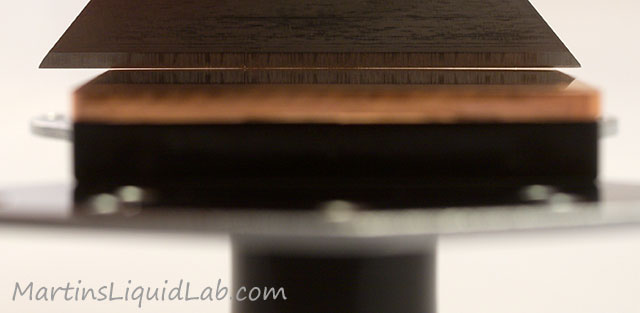
Here is the Apogee GT base when bowed, as you can see there is a fairly pronounced bow using the bowing o-ring. This maximized the mounting pressure above the cores and minimizes TIM thickness which in turn maximizes mounting efficiency. Many new blocks are coming out with a bowing system or stepping the base for this very reason. Very nice!
Kudos to Swiftech for giving you an exemplary complete package with everything you need, including an AMD kit!!

The base is a nice mirror finish, and bowed purposely around the center of the base.
When you take the block apart, you'll find only a few typical parts. The cast black aceta/delrin top with the chrome plated steel hold down, an o-ring, and a CNC machined copper base with a very fine diamond pin matrix design. Also note the top has funnel shaped flow spreader notches in the top, this allows the water to spread out from the barb holes and flow more evenly across the base.

Simple easy to maintain design, just note that the diamond pins must be oriented correctly such that they point from one barb to the next and don't restrict flow too much.

Just for scale, you can see each diamond pin is very small, this is likely cut using CNC milling machines and jewelers slitting saws.

One issue I had with my particular copy was machining burs left behind. Typically these are removed by bead blasting. I did not see this in my Apogee Drive which is the same base nor my old MCW-60 which has similar construction, so I think this was more of the exception and not typical. Regardless, I had burs present, so I spent a few minutes with a razor blade and cleaned out those burs, this would ensure performance more closely matches a typical block.

Here is a macro of the pins after clean, they are all very uniform and precisely machined and of the diamond shape.
This diamond pin shape prevents the water from standing still, it is constantly being split and scrubbing the walls of the pins.

Here is the Apogee GT base when bowed, as you can see there is a fairly pronounced bow using the bowing o-ring. This maximized the mounting pressure above the cores and minimizes TIM thickness which in turn maximizes mounting efficiency. Many new blocks are coming out with a bowing system or stepping the base for this very reason. Very nice!
Flow Rate and Restriction
I normally do pressure drop testing, I haven't completed that yet. I did however measure the actual flow rate I was getting from the block which gives you at least a relative measure of restriction. This was measuring using my King Instruments Flow rate meter in the actual loop I've been doing all of my water block testing. This includes an XSPC Reservoir Top on a DDC3.2 pump, a TFC 480ER radiator, and several lengths of tubing, along with some open valves and my flow meter.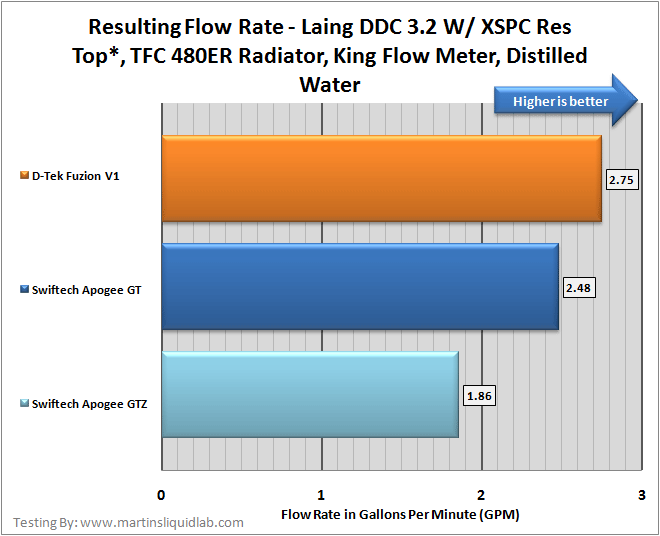
The results are very good, actually higher than I expected. It's much closer than the very low restriction D-Tek Fuzion V1 than I expected. This means the block has relatively low restriction and would serve well in multiple block loops and with the use of smaller pumps.
Thermal Test Specifications (for us testing geeks)
For thermal testing I decided to try and follow a 5 mount method of logging temperatures. Here are some of the specifics in my testing method: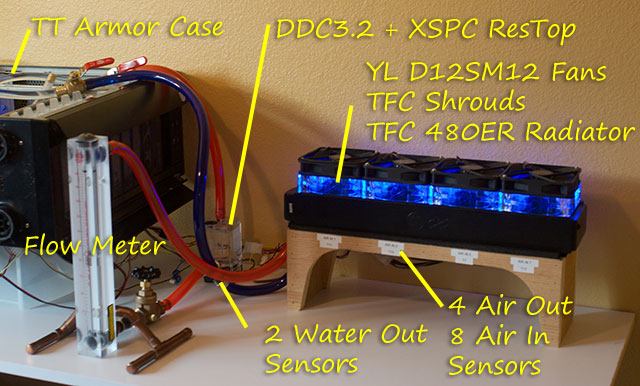
- Real World Full System Testing - Over time I developed a radiator testing bench that I've decided to incorporate into my CPU block testing setup. This gives me a full 8 air inlet sensors, 4 air outlet sensors, and two water sensors to much more precisely monitor everything. My testing occurs as close to the real world as possible, I just have a crap load of sensors on everything. I am testing on a processor, with a loading program, in a real world computer case, with a fixed pump, and a regular radiator setup. All of this helps include the little odd things that actually occur in a regular system.
- Intel Core 2 Quad Q6600 Kentsfield Processor - Over clocked to 3600 MHz, 65nm, Vcore = 1.472 under load. Motherboard is a DFI Lanparty X48 LT with 4GB of Corsair Dominator memory with fan module. The north bridge and south bridge chips are both water cooled. Video card is an EVGA 8800GTX, also watercooled. Video card and chipset on a separate loop running a D5 pump with EK pump top and HWlabs 480GTX radiator. Case is a Thermaltake Armor, position is horizontal for easy block mounting case cover left off.
- 5 separate TIM applications and mounts averaged - This is not common, but extremely important. It's not uncommon at all to see mounting variations as high as 2 degrees or more, so with only one mount, that error can be as much as 2 degrees. When you mount 5 times and average those results, your standard deviation is significantly lowered and the overall testing confidence improved. In addition multiple mounts serve as a means to validate data, because each test is carried out again and again, chances are if some variable is wrong affecting results, it will show.
- Logging temperatures - After several iterations of a new testing methods I finally landed on logging of temperatures for 1 hour. I then can simply start up the loading routine, trigger on my two logging programs and A/C unit and walk away for an hour. I then come back and remove the first 10 minutes for warm-up time. The remaining 50minutes is then left to average out temperatures which are recorded every second over 18 active sensors plus 4 core temperatures. Logging is essential for higher resolution measurements. Our DTS core sensors are only resolved to 1C, however after logging that resolution out for 50 minutes of testing, that can be reduced significantly. In addition my ambient temperatures are held constant by an A/C system thermostat that actually makes the temperature swig up and down in a saw-tooth like fashion over a 2C difference. Logging this saw-tooth occurrence over a long period of time also levels out the ambient to a nicely resolved level of accuracy. While it's still not by any means an environmental chamber, I have been able to keep ambients fairly consistently around 21.7C
- Temperature Probes Deployed - I kept my sensors fairly basic, but I did run a few extra's just for interesting information. This includes a sensor for:
-
- 2 ea Water Out sensors (After radiator and before CPU block) Dallas DS18B20 Digital one-wire sensors, and CrystalFontz CFA-633
- 8 ea Air In Bottom (Bottom inlet side of radiator) Dallas DS18B20 Digital one-wire sensors, and CrystalFontz CFA-633
- 4 ea Air Out Top (Top out side of radiator) Dallas DS18B20 Digital one-wire sensors, and CrystalFontz CFA-633
- 4 ea Q6600 DTS sensor these were logged using Core Temp Beta Version 0.94. I chose this particular version because it stacks logged data cores in separate column which makes integrating into my crystalfontz data much easier.
- Crystal Fontz logging is accomplished through the use of their Cyrstalfonts 633 WinTest b1.9. Only special settings are turning off all packet debugger check boxes to avoid paging the processor.
- The Dallas DS18B20 Digital one-wire sensors that were used as noted above have a specified absolute accuracy of .5C with a .2C accuracy between 20 -30C temperature range. They also have resolution down to .0625C which is very good, and because they are digital they are not affected by the wiring or length of wire like thermocouples are.
- The CrystalFontz CFA-633 is an LCD with up to 32 channels of monitoring and logging capability. It logs temperatures of each channel on a one second interval, so over a 30 minute test, I'll have about 1,800 entries noting time and temperature of each channel. These are then averaged for a fairly accurate number.
- Pump - Laing DDC3.2 with XSPC Reservoir top. I think this pump represents the pumping power available to many users and gives a fair amount of strong pumping power. This top rated near the top in my pump top testing and is very powerful.
- Radiator - The Feser Company (TFC) 480 ER radiator with Yate loon D12SL12 medium speed fans at 12V with TFC shrouds in pull condition. This is an extremely powerful radiator and was purposely chosen because the smaller water/ambient deltas reach equilibrium fast and pressure drop for this radiator is minimal. This provided me very short warm-up periods and ensured maximum pumping power for the CPU blocks being tested. Yeah I know it's overkill for a CPU only loop, but I like it that way..:)
- TIM Material - While I really like the TIM consultants TC Grease 0098, I found the thicker consistency wasn't helping with mounting consistency and required user effort to seat the block down. For that reason I chose Artic Cooling MX-2, it's been very popular in the forums and preliminary testing showed it to perform well, it's noted as non-curing, and more importantly is a thickness/consistency that more accurately represents most thermal compounds and easily applied and removed. I felt this was important to maintaining a higher level of repeatability. There was no cure time allowed for the compound ( it's noted as a non curing compound). Testing was started immediately following block installation. TIM installation method is a heavy thin line method. I shoot to achieve nearly full IHS coverage in my application.
- Hardware - I've change my review process to include testing of two options. First an "As shipped" option that includes what you get in the box with the block, nothing more. This forces me to make due and use the hardware included and provides users some evaluation and performance of what you get straight from the box. In addition I plan to use a fixed hardware scenario to more closely look at the block only.
- Prime 95 Load - I used Prime 97, torture test, Custom, Min FTT 8K, Max FTT 8K, Run FFTs in place checked ON. This is an easy to use and consistently loading program. It provided the most consistent loading I could find for quad cores. I also experimented with OCCT 2.0.0a which worked fairly well, but the plotting routing caused some processor paging spikes that prime 95 did not show. There is also heavier loading programs such as Linpak, but prime 95 is a strong enough load to meet or exceed most real world applications, so I feel it is a good fit.
- Lapped IHS - My Q6600 has been lapped flat down to 1200 grit to ensure a true and flat surface. The stock Intel IHS can be very irregular, some are convex, some are concave, some are wavy, and some are fairly flat. Lapping a processor voids it's warranty, but it ensures a nice flat surface for optimal heat transfer. My particular processor has been lapped. A complete stock IHS may benefit more from a bowed block than my samples because it is flat.
- Fixed Ambient Temperature - My recent roundup of block testing brought forth that regardless of measuring water temperature you will in fact still incur testing error of the processor core temperatures if you allow ambient temperatures to fluctuate. I found on the order of .2 t .3C error for every degree in ambient difference, although it was too variable to pin down and appropriately correct for. In the end I decided on buying a window A/C unit that holds all testing to the same temperature. Ambient do go up and down as the thermostat kicks on and off, but the overall average temperature over a long logged test has been holding to less than .5C which is very good. I am running a Hair 8,000 BTU thermostatically controlled A/C unit in "Cool fan on at all times" to keep temperatures right at 22C.
Thermal Test Round 1 As-Shipped
First up is my review of the block tested as shipped straight out of the box with nothing more than installation of the block as most users would make use of it. The only exception is that I cleaned the block base pins as noted above to remove machining burs. First I'm including the summary table of the raw data collected...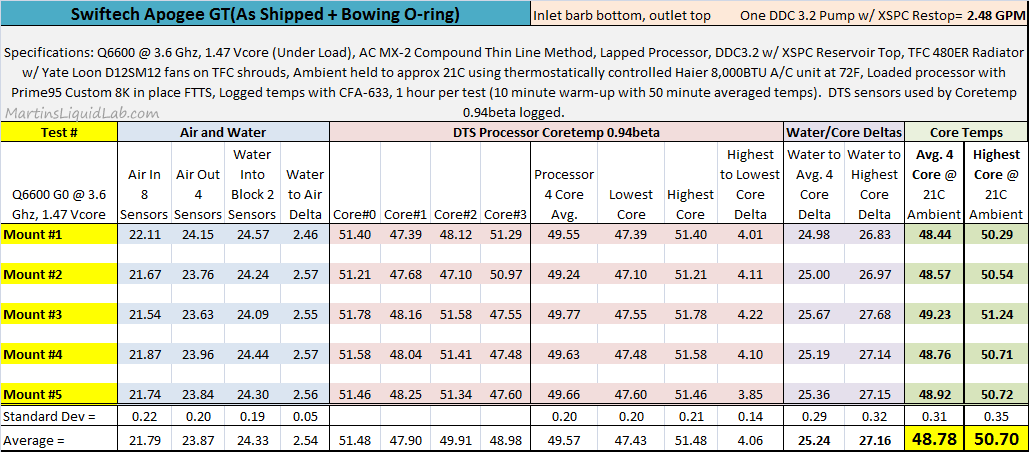
Overall testing conditions were held fairly constant thanks to my window A/C unit and logging the results. Ambient were held on average to 21.8C, water to core deltas were held to 2.5C thanks to the mighty TFC480 radiator, and the average high to low core delta was about 4 degree C.
And to have a look at those results graphically over the range of mounts that I ran, you can see those results here:
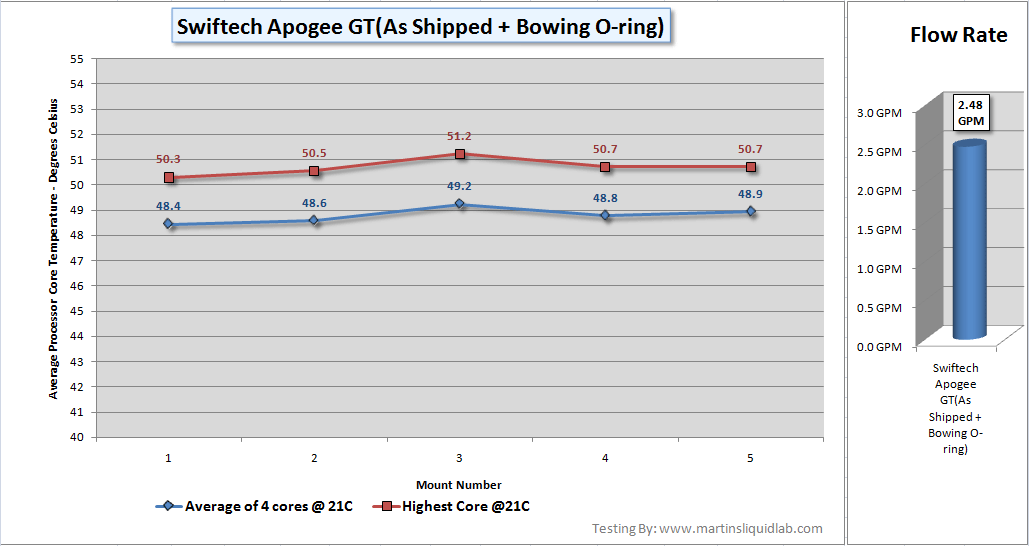
Mounting consistence produced results that were within about a .4C standard deviation, and the hottest core ran about 50.7C on average.
Thermal Test Round 1 Compared to the Apogee GTZ
It's always interesting to me to see various blocks of the same manufacturer compared, here is the GT vs. Fuzion V1 vs. the GTZ.
This chart shows the average temperature across all four cores. It's average about 2C higher average core temperatures than the flagship GTZ block. This is actually doing a fine job of keeping the Q6600 cool even at the over-clocked 3.6Ghz and 1.47 Vcore, it's not having any sort of problem running Prime 95 for 5 hours straight here.
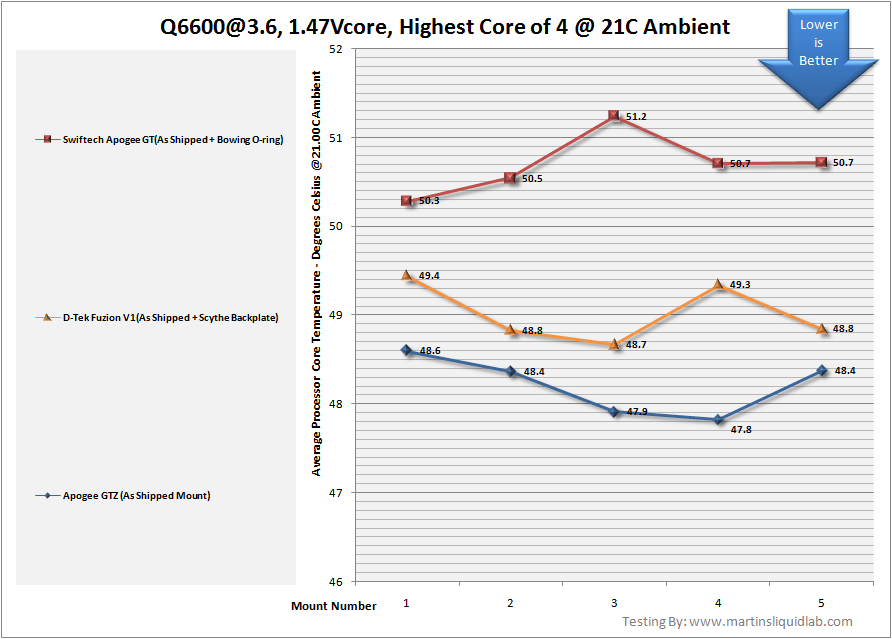
This graph does the same thing, but picks out the hottest of 4 cores. This is where the flagship block starts pulling further away, leaving about a 2.5C gap.
Compared to Air Cooling
As a little side experiment, I tried one mount of my old Scythe Infinity tower air cooler (that's what I ran before I went to water) with a Yate Loon D12SM12 fan attached in pull just to see how this lower cost CPU block would compare to a decent air cooler.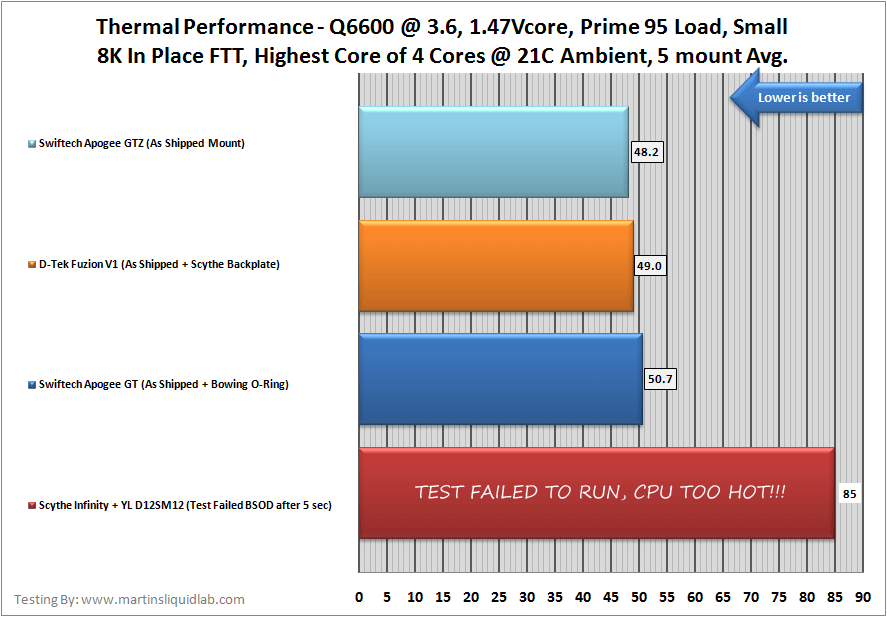
I gave up after one mount of the air cooler, prime 95 would BSOD the system in just a few seconds. After removing the cooler I could see my thermal paste spread wasn't a good as I would like, but regardless it was clear enough for me this is just too much heat for air. So relative to air cooling, the Apogee GT combined with an excellent pump and oversized radiator can really do a fine job at cooling a very hot processor down to very good levels.
Pros
- An exemplary accessory package, this ensures that a wide range of users have everything they need to install the block into their systems.
- Low Restriction, while not quite as low as the Fuzion V1, it's very good and very good for multiple block loops or smaller pumps
- Back-plate is and all accessories needed are INCLUDED!!! VERY NICE!!
- Delrin (Black Acetal) top, steel hold down, ensures long term durability
- Diamond pin matrix is capable of being cleaned by razor blade if needed
- Bowing O-ring provides good core contact.
- Does a find job cooling a Q6600 @ 3.6Ghz, and much much better than air cooling.
Cons
- Plastic barbs
- Thermal performance while plenty adequate is not up to high end block performances such as the Apogee GTZ
- Quality Control on copper base. My copy required manual removal of machining burs.
Bottom Line
The Swiftech Apogee GT while having been around a while now, is still a great performing block at an excellent price. Considering the lower price point, and capability, it will serve well in most systems. It kept my Q6600 at 1.47Vcore just over 50C for Prime 95 small 8K FTT loading, which is something my old Scythe Infinity air cooler could not do. Overall it's a simple classic design that works well and it comes with a very complete accessory package.Where to buy


